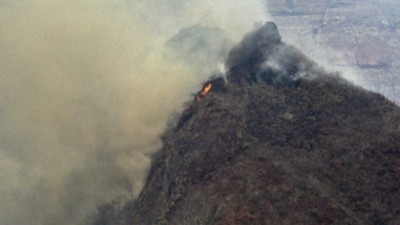- News
- City News
- delhi News
- How Delhi reacts to crop burning
Trending
This story is from September 25, 2019
How Delhi reacts to crop burning

Representative image
NEW DELHI: East, central and north Delhi areas are most affected by the crop stubble burning in Punjab and Haryana, while south and southwest Delhi areas are the least impacted during peak burning days. These were the preliminary findings of a recent IIT-Delhi research, showing that the effects of stubble burning are not homogeneous over different parts of the capital.
Vimlesh Pant, who is working on a project on the role of geographical and meteorological data to predict air pollution, said detailed examination of 2017 and 2018 revealed these findings.“We used a three-dimensional weather research and forecasting model to access the impact of stubble burning in these two neighbouring states on the concentration of fine particles of less than 2.5-micron diameter, or PM2.5,” said Pant, an associate professor at Centre for Atmospheric Sciences at IIT-Delhi. The project is under the aegis of Centre of Excellence for Research on Clean Air (CERCA) at the institute.

“Larger impacts were seen over the north, north-eastern, central, and eastern parts of the capital, whereas south-western and south Delhi were least affected during the stubble burning episodes of first week of November 2017 and third week of October 2018,” the professor added.
“The direction of plume is from northwest to southeast over Delhi-NCR during October-November, when the stubble burning is at its peak. The meteorological conditions during this period create stagnation of particulate matter over the Indo-Gangetic plain and help in the build-up of air-pollution over Delhi-NCR,” he said.
Most farmers in north India, especially Punjab and Haryana, prepare their fields for the wheat crop in October-November by burning the stubbles left after rice has been harvested.
Earlier this month, chief minister Arvind Kejriwal announced seven-point Parali Pradushan action plan along with a slew of other measures to combat high-level of air pollution, “caused due to stubble burning in neighbouring states” during winters.
Open biomass burning contributes to PM2.5 in Delhi by 20-25%, a recent Teri report says. However, experts say that stubble burning is only a seasonal issue and happens only during October and November.
“In the last three years, there has been a decline in stubble burning. Punjab and Haryana gain more attention because the air gets transported partly to Delhi. We have found that 45-50% time air from these two states come to Delhi during the peak burning season,” Sagnik Dey, associate professor, Centre for Atmospheric Sciences, IIT-Delhi, and coordinator, CERCA, earlier told TOI.
Vimlesh Pant, who is working on a project on the role of geographical and meteorological data to predict air pollution, said detailed examination of 2017 and 2018 revealed these findings.“We used a three-dimensional weather research and forecasting model to access the impact of stubble burning in these two neighbouring states on the concentration of fine particles of less than 2.5-micron diameter, or PM2.5,” said Pant, an associate professor at Centre for Atmospheric Sciences at IIT-Delhi. The project is under the aegis of Centre of Excellence for Research on Clean Air (CERCA) at the institute.

“Larger impacts were seen over the north, north-eastern, central, and eastern parts of the capital, whereas south-western and south Delhi were least affected during the stubble burning episodes of first week of November 2017 and third week of October 2018,” the professor added.
According to Pant, the variations in the PM2.5 concentrations due to stubble burning largely depend on meteorological conditions, such as wind speed, wind direction, boundary layer height, among other parameters.
“The direction of plume is from northwest to southeast over Delhi-NCR during October-November, when the stubble burning is at its peak. The meteorological conditions during this period create stagnation of particulate matter over the Indo-Gangetic plain and help in the build-up of air-pollution over Delhi-NCR,” he said.
Most farmers in north India, especially Punjab and Haryana, prepare their fields for the wheat crop in October-November by burning the stubbles left after rice has been harvested.
Earlier this month, chief minister Arvind Kejriwal announced seven-point Parali Pradushan action plan along with a slew of other measures to combat high-level of air pollution, “caused due to stubble burning in neighbouring states” during winters.
Open biomass burning contributes to PM2.5 in Delhi by 20-25%, a recent Teri report says. However, experts say that stubble burning is only a seasonal issue and happens only during October and November.
“In the last three years, there has been a decline in stubble burning. Punjab and Haryana gain more attention because the air gets transported partly to Delhi. We have found that 45-50% time air from these two states come to Delhi during the peak burning season,” Sagnik Dey, associate professor, Centre for Atmospheric Sciences, IIT-Delhi, and coordinator, CERCA, earlier told TOI.
End of Article
FOLLOW US ON SOCIAL MEDIA










